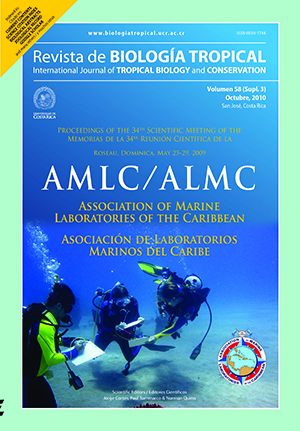Abstract
The coral reefs, seagrasses and mangroves from the Costa Rican Caribbean coast have been monitored since 1999 using the CARICOMP protocol. Live coral cover at Meager Shoal reef bank (7 to 10m depth) at the Parque Nacional Cahuita (National Park), increased from 13.3% in 1999, to 28.2% in 2003, but decreased during the next 5 years to around 17.5%. Algal cover increased significantly since 2003 from 36.6% to 61.3% in 2008. The density of Diadema antillarum oscillated between 2 and 7ind/m2, while Echinometra viridis decreased significantly from 20 to 0.6ind/m2. Compared to other CARICOMP sites, live coral cover, fish diversity and density, and sea urchin density were low, and algal cover was intermediate. The seagrass site, also in the Parque Nacional Cahuita, is dominated by Thalassia testudinum and showed an intermediate productivity (2.7±1.15 g/m2/d) and biomass (822.8±391.84 g/m2) compared to other CARICOMP sites. Coral reefs and seagrasses at the Parque Nacional Cahuita continue to be impacted by high sediment loads from terrestrial origin. The mangrove forest at Gandoca, within the Refugio Nacional de Vida Silvestre Gandoca-Manzanillo (National Wildlife Refuge), surrounds a lagoon and it is dominated by the red mangrove, Rhizophora mangle. Productivity and flower production peak was in July. Biomass (14kg/m2) and density (9.0±0.58 trees/100m2) in Gandoca were relatively low compared to other CARICOMP sites, while productivity in July in Costa Rica (4g/m2/d) was intermediate, similar to most CARICOMP sites. This mangrove is expanding and has low human impact thus far. Management actions should be taken to protect and preserve these important coastal ecosystemsComments

This work is licensed under a Creative Commons Attribution 4.0 International License.
Copyright (c) 2010 Revista de Biología Tropical
Downloads
Download data is not yet available.






